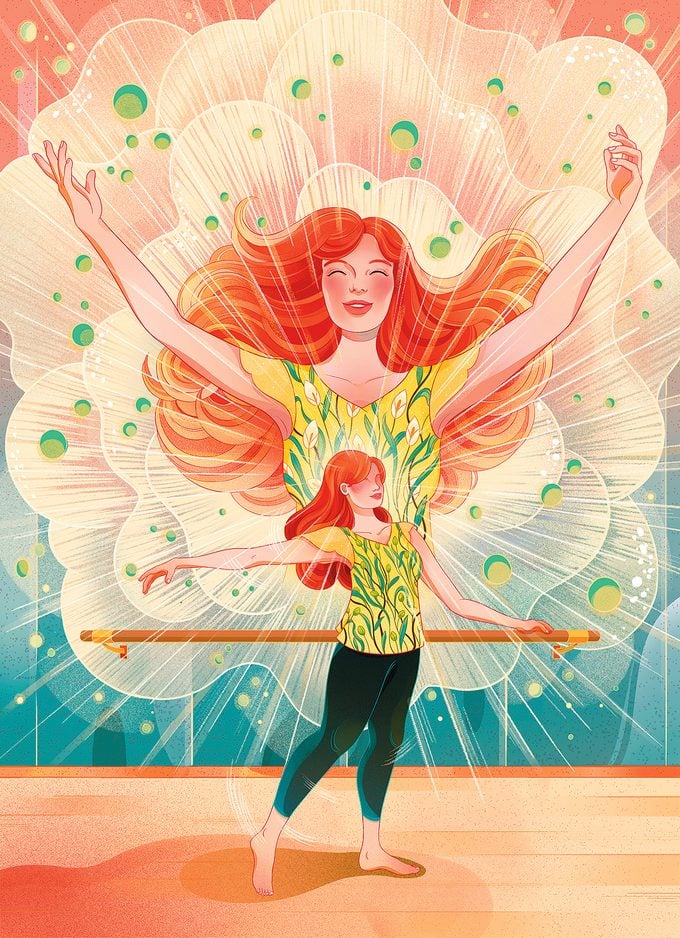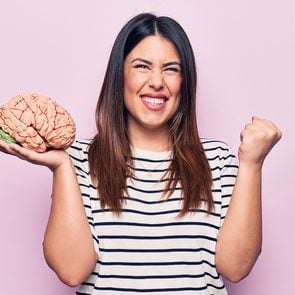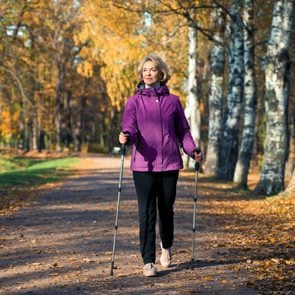How Dancing Helps People With Dementia, Parkinson’s and Multiple Sclerosis
Research shows dancing can help improve the lives of people with neurocognitive and movement disorders.

Dance as therapy
Wearing all black and sitting on a tufted white ottoman in her sparse and sunlit living room, Toronto-based Sarah Robichaud is teaching a modern ballet-inspired routine to a group of 80 students on Zoom.
The Bolshoi-trained dancer spreads her arms wide in exaggerated movements to a slow cover version of the Proclaimers’ “I’m Gonna Be (500 Miles)” as her students replicate the routine. “We’re just going to start with a gentle sway, back and forth,” she tells them. “I want you to imagine that there’s a thread attached to your wrist and someone’s pulling that thread from side to side.”
Many of Robichaud’s students are seated, as well. More than half of them have Parkinson’s disease and typically move with difficulty, but when they try to mirror her fluid and graceful movements, a look of ease comes over them.
“It’s profound,” says Robichaud, the founder of Canada’s non-profit Dancing With Parkinson’s program, which offers free daily dance classes online and in person. “I’ve been doing this for 16 years, and every week at some point while I’m teaching I’ll catch a glimpse of one of the dancers, and I literally have to choke back my tears.”
With growing evidence that dancing helps boost brain health and manage symptoms of neurocognitive and movement disorders, including Parkinson’s, multiple sclerosis (MS), Alzheimer’s, dementia and even brain injury, accessible dance programs and movement therapists around the world are helping improve the lives of millions.
Robichaud has seen the benefits first-hand. After she took an innovative teaching program at the Mark Morris Dance Group in New York in 2007, she started Dancing With Parkinson’s to give back to her community in Toronto.
A few years later, her grandfather was diagnosed with Parkinson’s. Sadly, he passed away in 2013 due to complications related to the disease, though Robichaud danced with him in his long-term care home until his final days. Those memories are reignited every time she teaches, says Robichaud. “The compassion and care that I have for our dancers is that they’re all my grandfather.”
Recently, one of Robichaud’s students, a man in his 50s who, before trying the program, was adamant that dancing wasn’t for him, said that he now has more dexterity in his hands and generally moves more freely. “I cannot deny how this is changing my life,” he told her.
Her students aren’t imagining it. Various studies have shown that activities that target skills such as balance, coordination, flexibility, creativity and memory work can improve Parkinson’s symptoms. And for many, dance is one of the most enjoyable and efficient ways of doing so: A 2021 York University study showed that weekly dance training improved motor function and daily living for those with mild-to-moderate Parkinson’s disease.
So what is it about dance that’s different from a brisk walk or other aerobic exercises?
Dance as medicine
Helena Blumen, a cognitive scientist at Albert Einstein College of Medicine in New York City, says the intricate mental multitasking that dance requires engages various parts of the brain at the same time, which can lead to the strengthening of neural connections across different brain regions. Basically, dancing requires more “brain power” than simpler repetitive exercises. “It’s socially, cognitively and physically demanding,” Blumen says.
Anyone who’s ever felt the irresistible urge to sway to their favourite song knows that combining music and movement—described by one researcher as “pleasure double-play”—can lift your mood and melt away stress. But there’s a lot more happening in the brain when trying to follow even the simplest choreography.
“In dance, we have to learn patterns, think symmetrically and asymmetrically, and remember sequences,” says David Leventhal, program director and founding teacher at the Mark Morris Dance Group’s Dance for PD program, where Robichaud trained. The effect extends beyond the dance class to the real world. Tasks like navigating the kitchen or walking to the bus stop can become more attainable if they are regarded as choreography.
While scientists are still learning how the mechanisms of dancing work in the brain, a clearer picture is beginning to emerge. In 2018, researchers at Otto von Guericke University in Magdeburg, Germany, did MRI scans of older adults who had participated in one of two programs over six months: one group practised dance and the other did a traditional exercise program with cycling and strength training.
Both groups improved their level of physical fitness, but the dancers grew more white and grey matter in the parts of the brain that are responsible for cognitive processes, such as working memory, attention and high-level thinking. White and grey matter typically decline as we get older, making communication in the brain lag and certain cognitive tasks, such as multitasking and problem solving, tougher.
What’s more, the dancers showed an increase in blood plasma BDNF, a protein known to play a crucial role in the development of brain plasticity.
Together, the researchers hypothesize, these brain changes contribute to more neuroplasticity, which is the brain’s ability to form new connections and pathways.
Imagine your brain is like a city with loads of roads and pathways. Neuroplasticity is akin to the city’s ability to build new roads, repair old ones or even change the direction of traffic based on how often the routes are used and what the city needs.
So, just as cities adapt and change over time to meet the needs of people, our brains can reshape and adjust based on our experiences and learning.
In a different study in 2022, Blumen and other researchers from Albert Einstein College of Medicine found that social ballroom dancing, when compared with treadmill walking among adults over 65, was associated with reduced atrophy in the hippocampus—a brain region that is key to memory functioning and is particularly affected by Alzheimer’s disease. In other words, the dancers’ memory centre isn’t shrinking as quickly, potentially slowing the disease’s progression and improving overall quality of life.
Similar studies have shown the benefits of dance in conditions ranging from MS and Huntington’s disease to autism and depression. Dance therapy might even help people with brain injuries. A small Finnish study of 11 people with severe traumatic brain injury showed that dance-based rehabilitation may improve mobility, cognition and overall well-being.
Dance as body acceptance
In addition to the physical and neurological benefits, dance can also help people living with disease accept what their bodies can and can’t do.
“Dance is about befriending the body as a catalyst for self-awareness, agency, motivation and acceptance,” says Erica Hornthal, a Chicago-based dance and movement therapist, a clinical counsellor and author of Body Aware: Rediscover Your Mind-Body Connection, Stop Feeling Stuck, and Improve Your Mental Health With Simple Movement Practices. Rather than trying to control, or “fix,” our body, dance is about developing greater body awareness and moving at our capacity, regardless of physical or cognitive difference, she says.
Dawnia Baynes, 44, was diagnosed with MS in 2006, when she was in her mid-20s, after her body went numb from the chest down. Nearly two decades later, her hands are still numb, and she suffers from severe muscle tightness and balance issues, which make standing and walking difficult.
She recently joined an online dance program run by the University of Florida for people with MS. Not only has it improved her coordination and range of motion, it has enabled her to overcome her fear of being judged for how she moves, both in the dance class and out in the world.
“To see other people moving like I’m moving,” she says, “and know that I don’t have to be professional and super technical in my dancing or make sure my leg lifts this way—it made me comfortable with where I am right now.”
Dance as community
Perhaps one of the biggest benefits of dance is the sense of community it creates. Dancing with others not only makes people feel less different in their abilities when dealing with neurological and movement disorders, it also helps to combat the loneliness and social isolation of living with a chronic illness. Allowing those broader connections is one of the reasons why programs initially intended only for people with Parkinson’s and MS have opened up to everyone.
Echoing this sentiment, Leventhal says he’s struck by how many participants consider these classes a lifeline. Since he started teaching more than 22 years ago, the Dance for PD model has been adopted by 300 communities in 28 countries around the world. Some, such as India and South Korea, have incorporated their own cultural dance styles into the class model.
“They’ve come to rely on it in a way that it is an essential part of their Parkinson’s management. It’s not an extra thing that they do because they like to do it,” he says, explaining that for many participants, dance has become vital to their quality of life.
Still, researchers say they’re only scratching the surface of understanding how dance can be used therapeutically. Larger studies are needed to confirm the findings of the smaller trials that have been done so far. Additional studies are also needed to pinpoint the most effective types of dance movements and the optimal length and frequency of classes. It’s also unclear who would benefit most, in terms of age or disease progression.
Those who aren’t drawn to dance may want to try other brain-stimulating physical activities, such as tai chi or yoga, says Notger Müller, a health-sciences professor at the University of Potsdam who co-authored the Otto von Guericke University study. But for people simply hung up on the idea of dancing in public, online classes make it easy to dance from the comfort of home—like no one is watching. (Many of Robichaud’s Dancing With Parkinson’s online Zoom participants leave their cameras off.)
Robichaud’s mission with dance is to create a sense of community and family—so much so that she sometimes takes the program on the road and teaches the class from dancers’ homes across Ontario. Wherever she teaches, her message is one of hope: “We want you to feel joyful, to get more involved in your community, to explore the limitless possibilities for the rest of your life.
Next, check out this deep-dive into the breakthroughs in dementia research.






